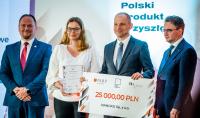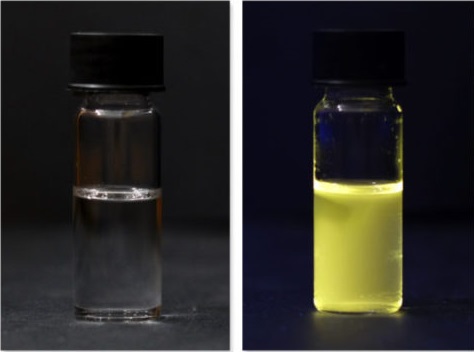Oxygen-zinc materials of the future

The project was awarded in the Polish Product of the Future competition, photo: Polish Agency for Enterprise Development
Researchers from the Faculty of Chemistry have developed a method for producing zinc oxide (ZnO)–based nanomaterials from organometallic precursors. The technology was implemented and then developed by Nanoxo. The solution has a wide range of industrial applications, and it was recently recognized in a competition promoting Polish innovations.
The awarded nanomaterials are multifunctional zinc oxide (ZnO) quantum dots and zinc peroxide (ZnO2) nanoparticles. They are primarily characterized by their long-term stability (regardless of storage conditions) and the ability to create colloidal solutions in any chosen medium. The process of their creation is also unique. This is because it enables the controlled and repeatable production of nanomaterials. As a result, they are characterized by unique on a global scale quality and uniformity, as well as a high degree of purity. Importantly, the final properties can be adapted to fit the specific application already at the synthetic stage.
Additionally, the ZnO2 nanoparticles exhibit high antibacterial activity. They are also safe and biocompatible. Unlike other semiconductor nanomaterials, they do not contain heavy metals or any residues from the synthetic process, and despite their small size, they do not exert significant cytotoxic effects.
Developed in such a way safe oxygen-zinc nanostructures have numerous applications in both industry and daily life. The potential applications include luminescent pigments, transparent lacquers and inks for anti-counterfeiting uses, tags used in waste sorting and disposal processes, and luminescent decorative coatings. The materials will also find use in transparent coatings with long-lasting antibacterial, antiviral, and antifungal properties, wound healing agents and dressings, nanostructured UV-filters, photovoltaics or QLED diodes.
The method of producing nanomaterials based on zinc oxide (ZnO) was developed by Małgorzata Wolska-Piętkiewicz, PhD, Eng., Maria Jędrzejewska and Prof. Janusz Lewiński from the Faculty of Chemistry. Nanoxo implemented the technology in 2020, and later developed a new synthetic approch to create zinc peroxide (ZnO2) nanoparticles.
This comprehensive solution was awarded in the Entrepreneur's Product of the Future category of the Polish Product of the Future competition. The team that is responsible for the success includes: Małgorzata Wolska-Pietkiewicz, PhD, Eng. (WUT Faculty of Chemistry, Nanoxo CTO – project manager), Prof. Janusz Lewiński, PhD, DSc. (WUT Faculty of Chemistry, founder of Nanoxo), Julia Wielgórska, MSc, Eng. (she is currently pursuing an implementation doctorate at Nanoxo), Maria Jędrzejewska, MSc. Eng. (PhD student at the WUT Faculty of Chemistry), Łukasz Sadowski, DSc, PhD, Eng. (Nanoxo COO), Emil Bojarski, MSc, Eng. (Nanoxo CEO).
The Polish Product of the Future competition promotes Poland's most innovative products and technologies. These include innovations from various areas of technology, such as the medical, pharmaceutical, electronic, and chemical industries. This year the competition was held for the 24th time. It is organized by the Polish Agency for Enterprise Development and the National Centre for Research and Development.









